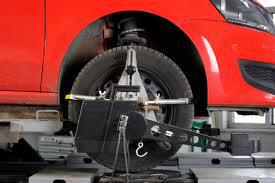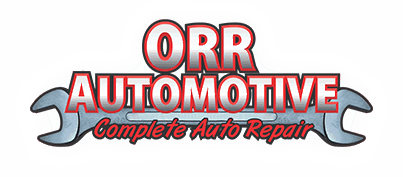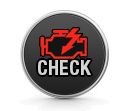
There are times when something just does not feel right when you are driving down the road. When that happens; it is time to give us a call at Orr Automotive. Maybe the ride is not as smooth as it used to be. Maybe your vehicle pulls to the left or the right.
Perhaps your steering wheel is not straight up and down when your hands are positioned at 10 and 2. Are your tires making noises such as squealing when you are making a turn? Is your mpg off or are your tires wearing out faster than they used to? All of these issues can be attributed to alignment problems. Sometimes these problems are so subtle you can’t even feel them. Stop by so we can help your tires and fuel. Together we can make your car go the distance. Keeping your car on the road has never been easier!
What is an Alignment Check?
- Inspect steering and suspension system, including tire condition and air pressure
- Put vehicle on alignment rack; mount and compensate sensors
- Print out wheel alignment readings
What does a Standard Alignment Include?
- Inspect steering and suspension system, including tire condition and air pressure
- Put vehicle on alignment rack; mount and compensate sensors
- Print out initial alignment readings
- Adjust camber, caster and toe angles to manufacturer specifications, if applicable (additional parts and labor may be necessary on some vehicles — see your auto care advisor for details)
- Print out final wheel alignment readings to verify alignment is within specification
- Road test vehicle
Components in both the steering and suspension
systems determine the alignment of a vehicle's
wheels. Many of these parts, like tie rods and
control arms, are adjustable to compensate for
changes in the suspension and steering systems
over time.
The main alignment angles are toe, camber, and
caster. The "Toe" alignment angle determines
where the tires are pointed in relation to each other.
It is usually adjusted by the tie rods. When viewing
the vehicle from the front, toe-out occurs when the
front of the wheels are pointing away from each
other. On the other hand, toe in occurs when the
wheels are pointed in, towards each other. Vehicles
with excessive toe in or toe out can experience rapid
tire wear and may also experience feathering of the
tire tread.
The camber angle is the angle that the tire makes
relative to vertical. Negative camber suggests that
the top of the tire is tilted in towards the vehicle and
the bottom of the tire is tilted outwards.
Positive Camber is exactly the opposite where the
top is tilted out and the bottom tilted in. Excessive
camber in either direction can cause tire wear on
just one edge of the tire and can create a pulling
force that will cause the vehicle to drift as it moves
down the road. Camber angles are especially
affected by the suspension components. Worn
suspension springs and shock absorbers allow the
vehicle to sit lower, causing negative camber.
The caster angle is the angle between vertical and
the steering pivot axis. Caster can be adjusted by
moving the top of the struts forward or rearward.
Caster angles that are out of adjustment usually
won't cause tires to wear, but may cause the vehicle
to pull if caster angles differ greatly between the two
front wheels. Caster can also affect the steering
effort. Positive caster angles can increase steering
effort, but will create more straight line stability.
Caster angles close to 0 will decrease the steering
effort, but may cause the vehicle to wander when
traveling along the road.
wheel alignment is a maintenance service that ensures the wheels of their vehicle are properly aligned according to the manufacturer's specifications. Emphasize that accurate wheel alignment is vital for optimal performance and safety.
Tire Wear Prevention: Describe how wheel misalignment can lead to uneven tire wear. Explain that when the wheels are not properly aligned, certain areas of the tires may experience excessive friction and wear out faster than others. By getting a wheel alignment, they can extend the lifespan of their tires, save money on premature replacements, and maintain better traction on the road.
Improved Handling and Stability: Highlight how a proper wheel alignment enhances the vehicle's handling and stability. Explain that when the wheels are aligned correctly, it ensures that all four tires are pointing in the same direction and making even contact with the road surface. This results in improved steering response, better control, and a smoother ride, especially during cornering and at high speeds.
Enhanced Fuel Efficiency: Explain that wheel misalignment can cause the vehicle to experience unnecessary drag or resistance, which requires more power and fuel consumption to maintain forward motion. By getting a wheel alignment, they can improve fuel efficiency and save money on fuel costs over time.
Safety Considerations: Emphasize the importance of safety when it comes to wheel alignment. Explain that misaligned wheels can affect the vehicle's stability and handling, potentially leading to unsafe driving conditions. Proper alignment helps ensure that the vehicle maintains its intended stability, reducing the risk of accidents and providing better overall control on the road.
Suspension System Protection: Describe how a wheel alignment also helps protect the vehicle's suspension system. Misaligned wheels can put extra stress on various suspension components, such as ball joints, tie rods, and bushings. By maintaining proper alignment, they can reduce premature wear and tear on these parts, saving them from costly repairs down the line.
Manufacturer Recommendations: Mention that vehicle manufacturers often provide recommended intervals for wheel alignment as part of routine maintenance. Explain that following these guidelines helps maintain the vehicle's warranty coverage and ensures it performs optimally throughout its lifespan.
Professional Expertise: Assure the customer that a wheel alignment should be performed by a trained technician using specialized equipment. Explain that the technician will carefully measure and adjust the angles of the wheels, including camber, toe, and caster, to bring them back within the manufacturer's specifications.
Post-Alignment Testing: Mention that after the wheel alignment is performed, a test drive will be conducted to ensure everything is properly aligned and functioning as intended. This step ensures customer satisfaction and verifies that the alignment service has been successfully completed.
Components in both the steering and suspension
systems determine the alignment of a vehicle's
wheels. Many of these parts, like tie rods and
control arms, are adjustable to compensate for
changes in the suspension and steering systems
over time.
The main alignment angles are toe, camber, and
caster. The "Toe" alignment angle determines
where the tires are pointed in relation to each other.
It is usually adjusted by the tie rods. When viewing
the vehicle from the front, toe-out occurs when the
front of the wheels are pointing away from each
other. On the other hand, toe in occurs when the
wheels are pointed in, towards each other. Vehicles
with excessive toe in or toe out can experience rapid
tire wear and may also experience feathering of the
tire tread.
The camber angle is the angle that the tire makes
relative to vertical. Negative camber suggests that
the top of the tire is tilted in towards the vehicle and
the bottom of the tire is tilted outwards.
Positive Camber is exactly the opposite where the
top is tilted out and the bottom tilted in. Excessive
camber in either direction can cause tire wear on
just one edge of the tire and can create a pulling
force that will cause the vehicle to drift as it moves
down the road. Camber angles are especially
affected by the suspension components. Worn
suspension springs and shock absorbers allow the
vehicle to sit lower, causing negative camber.
The caster angle is the angle between vertical and
the steering pivot axis. Caster can be adjusted by
moving the top of the struts forward or rearward.
Caster angles that are out of adjustment usually
won't cause tires to wear, but may cause the vehicle
to pull if caster angles differ greatly between the two
front wheels. Caster can also affect the steering
effort. Positive caster angles can increase steering
effort, but will create more straight line stability.
Caster angles close to 0 will decrease the steering
effort, but may cause the vehicle to wander when
traveling along the road.
Components in both the steering and suspension
systems determine the alignment of a vehicle's
wheels. Many of these parts, like tie rods and
control arms, are adjustable to compensate for
changes in the suspension and steering systems
over time.
The main alignment angles are toe, camber, and
caster. The "Toe" alignment angle determines
where the tires are pointed in relation to each other.
It is usually adjusted by the tie rods. When viewing
the vehicle from the front, toe-out occurs when the
front of the wheels are pointing away from each
other. On the other hand, toe in occurs when the
wheels are pointed in, towards each other. Vehicles
with excessive toe in or toe out can experience rapid
tire wear and may also experience feathering of the
tire tread.
The camber angle is the angle that the tire makes
relative to vertical. Negative camber suggests that
the top of the tire is tilted in towards the vehicle and
the bottom of the tire is tilted outwards.
Positive Camber is exactly the opposite where the
top is tilted out and the bottom tilted in. Excessive
camber in either direction can cause tire wear on
just one edge of the tire and can create a pulling
force that will cause the vehicle to drift as it moves
down the road. Camber angles are especially
affected by the suspension components. Worn
suspension springs and shock absorbers allow the
vehicle to sit lower, causing negative camber.
The caster angle is the angle between vertical and
the steering pivot axis. Caster can be adjusted by
moving the top of the struts forward or rearward.
Caster angles that are out of adjustment usually
won't cause tires to wear, but may cause the vehicle
to pull if caster angles differ greatly between the two
front wheels. Caster can also affect the steering
effort. Positive caster angles can increase steering
effort, but will create more straight line stability.
Caster angles close to 0 will decrease the steering
effort, but may cause the vehicle to wander when
traveling along the road.








